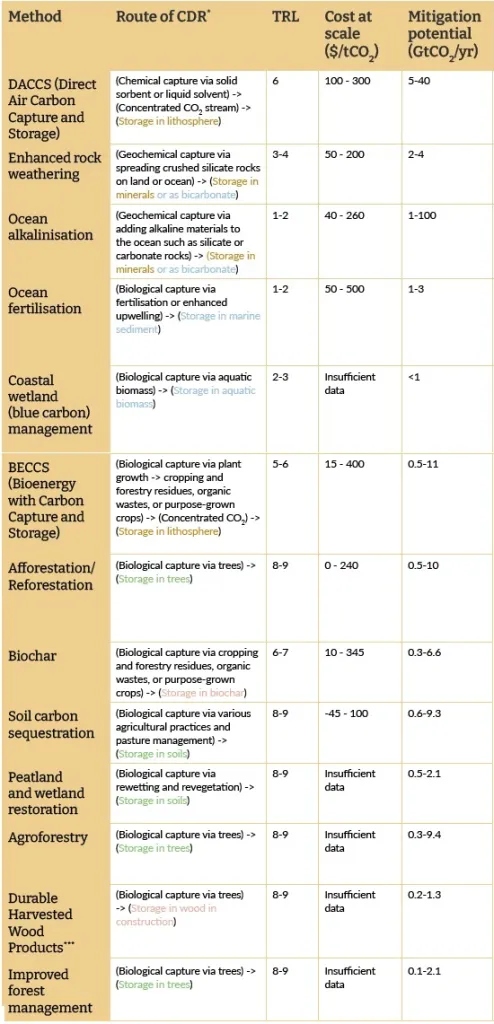Comments
- No comments found

Perhaps the simplest way of removing carbon dioxide from the atmosphere is to manage forests in such a way that they soak up more carbon.
But there are other ways, like capturing carbon directly from the air and then storing it deep underground, or in the form of mineral deposits. It’s perhaps not widely known that climate change models describing potential paths to reduce the risks of climate change typically assume that carbon dioxide removal will rise dramatically, and that it will be an important part of any ultimate solution. The University of Oxford’s Smith School of Enterprise and the Environment provides an overview of the science, policy, and public opinion in “The State of Carbon Dioxide Removal Report, 2023. The lead contributors are Stephen M Smith, Oliver Geden, Jan C. Minx, and Gregory F. Nemet.
Here’s a chart showing the various approaches to carbon dioxide removal in the first column and the route by which it works in the second column. The third column headed “TRL” stands for “Technology Readiness Level” ranked from theoretically possible at 1 to operationally ready at 9. The last two columns show an estimate of what cost for removing carbon might be if the technology was developed to large scale, and the potential for how much carbon it could remove (measured in gigatons of CO2).

Broadly speaking, these can be summarized into three categories of how the carbon is stored.
Biological storage (on land and in oceans). While annual plants do not retain carbon durably, trees can retain their carbon for decades, centuries or more. Soils and wetlands are a further store of carbon, derived from compounds exuded by roots and dead plant matter. In the oceans, aquatic biomass may sink to the ocean floor and become marine sediment. Carbon can be retained durably in these ecosystems, especially if managed carefully to reduce
disturbances.
Product storage. Many carbon-based products do not constitute durable storage. However, construction materials and biochar (a carbon-rich material produced by heating biomass in an oxygen-limited environment) can store carbon for decades or more. These carbon-based products can be made from conversion of harvested biomass (in the cases of biochar and wood in construction), from concentrated CO2 streams or even from CO2 from ambient air (in the case of aggregates).
Geochemical storage. Concentrated CO2 can be stored in geological formations, using depleted oil and gas fields or saline aquifers, or reactive minerals such as basalt. Geochemical capture leads directly to long-term storage of CO2 in the form of carbonate minerals or bicarbonate in the ocean.
The report emphasizes that it is extraordinarily unlikely that carbon dioxide removal can address atmospheric carbon levels on its own. The notion is that it can supplement other efforts. After all, all approaches that involve reduced use of fossil fuels only reduce the speed at which carbon is being added to the atmosphere, while the effect of carbon dioxide removal is actually to reduce pre-existing levels of carbon to lower levels than they would otherwise reach. The report argues:
Virtually all scenarios that limit warming to 1.5°C or 2°C require “novel” CDR, such as BECCS, biochar, DACCS, and enhanced rock weathering. However, only a tiny fraction (0.002 GtCO2 per year) of current CDR results from novel CDR methods. Closing the CDR gap requires rapid growth of novel CDR. Averaging across scenarios, novel CDR increases by a factor of 30 by 2030 (and up to about 540 in some scenarios) and by a factor of 1,300 (up to about 4,900 in some scenarios) by mid-century. Yet no country so far has pledged to scale novel CDR by 2030 as part of their Nationally Determined Contribution, and few countries have so far published proposals for upscaling novel CDR by 2050.
Indeed, if one looks at present at the amount of carbon dioxide removal, more than 99% is happening with reforestation, and about 0.1% involves the more novel forms of carbon dioxide removal listed in the table.
The other key point is that if at least some of these technologies are to be workable at scale, a lot of innovation and learning-by-doing is going to be needed over a sustained period of time. If countries aren’t starting a wide range of experimental projects in carbon dioxide removal very soon, then the necessary knowledge base won’t exist for large-scale use of carbon dioxide removal 2-3 decades from now. And to repeat myself, the main scenarios for mitigating the risks of climate change all include the assumption that this technology will become developed and workable. Without carbon dioxide removal technologies, the already very difficult task of dealing with rising levels of atmospheric carbon becomes much harder.
Timothy Taylor is an American economist. He is managing editor of the Journal of Economic Perspectives, a quarterly academic journal produced at Macalester College and published by the American Economic Association. Taylor received his Bachelor of Arts degree from Haverford College and a master's degree in economics from Stanford University. At Stanford, he was winner of the award for excellent teaching in a large class (more than 30 students) given by the Associated Students of Stanford University. At Minnesota, he was named a Distinguished Lecturer by the Department of Economics and voted Teacher of the Year by the master's degree students at the Hubert H. Humphrey Institute of Public Affairs. Taylor has been a guest speaker for groups of teachers of high school economics, visiting diplomats from eastern Europe, talk-radio shows, and community groups. From 1989 to 1997, Professor Taylor wrote an economics opinion column for the San Jose Mercury-News. He has published multiple lectures on economics through The Teaching Company. With Rudolph Penner and Isabel Sawhill, he is co-author of Updating America's Social Contract (2000), whose first chapter provided an early radical centrist perspective, "An Agenda for the Radical Middle". Taylor is also the author of The Instant Economist: Everything You Need to Know About How the Economy Works, published by the Penguin Group in 2012. The fourth edition of Taylor's Principles of Economics textbook was published by Textbook Media in 2017.
Leave your comments
Post comment as a guest